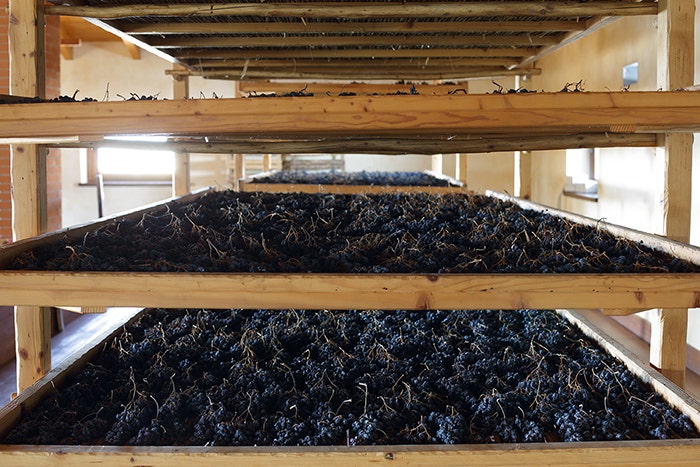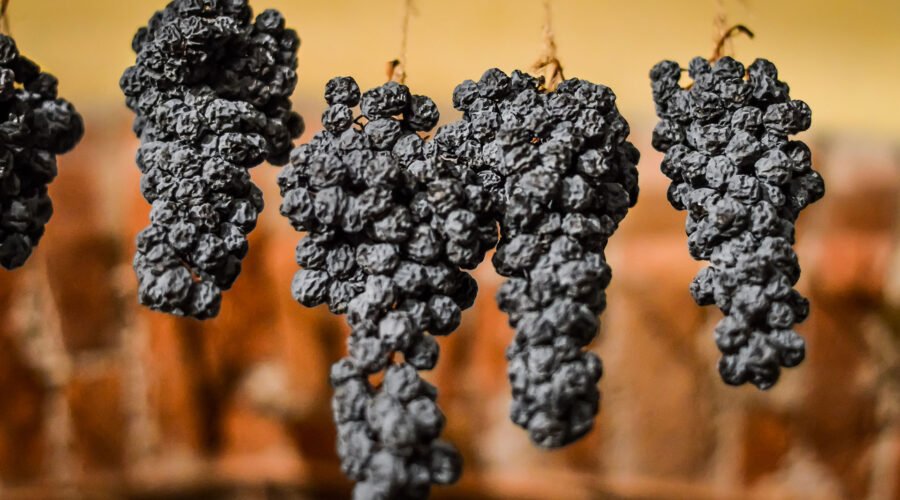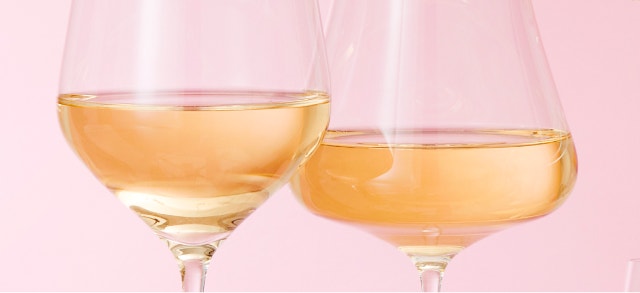What Does ‘Appassimento’ Mean in Wine?
Wine drinkers who love big, bold reds may already know to reach for Amarone di Valpolicella, an Italian wine blend of Corvina, small amounts of Corvinone and sometimes Rondinella grapes from the Veneto region. One of the key winemaking processes that gives Amarone its depth and complexity is a process called appassimento. But what is this style of winemaking and how does it give Amarone its signature flavor? Here’s what you need to know about this style and how it creates such compelling, unique wines.
What Does “Appassimento” Mean?
Appassimento translates to “fading” or “withering” in Italian and refers to a winemaking process where dried grapes, instead of fresh grapes, are fermented. When winemakers use the appassimento process, they create wines that are full-bodied and packed with intense fruit, balanced acidity and sometimes sweetness.
While the grapes in Amarone tend to take center stage when many think of appassimento, they’re not the only grapes processed in this style. You can find examples of wines using appassimento methods in northern Italy with Barbera and Sangiovese, as well as Moscato Ottonel and Vidal in Austria, the U.S. and Canada. The resulting wines can be dry or sweet.
It’s used in Italy to produce wine like Passito, Vin Santo ( Vinsanto ), Moscato di Pantelleria, Recioto, Recioto della Valpolicella, Passito di Caluso, Amarone della Valpolicella, Recioto di Soave, Torcolato, Ramandolo Passito, Refrontolo Passito. But also “Wine from Naturally Dried Grapes” (in South Africa), Vino de Pasas (in Spain), Slámové víno (in Slovakia), Vin de Paille (in France), Caballo Blanco (in Dominican Republic).
How Does the Appassimento Method Work?
Appassimento begins when producers pick ripe grapes, dry them out and ferment them into wine. By picking the grapes when ripe, as opposed to letting them dry on the vine, winemakers can maintain the grape’s acidity while creating deep flavor.
Andrea Millineux, co-owner and winemaker of Mullineux & Leeu Family Wines, told Wine Enthusiast in 2020, “When [grapes are] cut off the vine, it halts the ripening process, so you’re no longer losing acidity as the grapes become sweeter. You’re concentrating the sugar, but also concentrating the acidity.”
Once picked, the grapes are then dried. There are many methods of drying grapes, and it is determined by the winemaker’s preference and desired result.
For example, the Consorzio Tutela Vini Valpolicella, a group of wine producers, growers and bottlers dedicated to the quality of the Valpolicella wine production area, determine the standards for producing Amarone di Valpolicella. They stipulate that grapes must be dried for 100 to 120 days using air conditioning or “traditional” drying processes until the grapes have lost half of their weight.
To do this, winemakers can place their harvested grapes on wooden crates or bamboo drying mats, known as arelles, or plastic crates in large rooms during the drying process. This will later result in the deep red color, velvety mouthfeel and notes of dried fruit and spices characteristic of Amarone di Valpolicella.
The traditional drying process relies on natural air circulation, with “a window on one side and a window on another side [to allow] the wind in winter [to] come across,” says Bill Nesto, MW. This can keep the grapes from molding, he adds.
For red wines like Amarone, this mold isn’t a bad thing. The mold, also known as Botrytis or noble rot, offers another layer of complexity to the final product. “A lot of the compounds in the skin add richness and aroma to wine,” explains Nesto.
He adds that the mold can make the grapes more floral and less fruity while maintaining sweetness, too. In contrast, grapes that don’t have noble rot, have more anthocyanins, says Nesto, resulting in a darker wine with less sweetness but more fruit and structure.
What Kind of Wine Is Appassimento?
Once a producer has dried the grapes, they can make sweet dessert wine, like Recioto, or dry wine, like Amarone.
If a winemaker wants a sweeter wine, they’ll use a sweet winemaking process where fermentation stops earlier—creating a wine with about 50 grams per liter of residual sugar, according to the Consorzio Tutela Vini Valpolicella.
However, if they let the process continue until the yeast has died out, the final product will be less sweet and have higher alcohol, like Amarone. This is limited to nine grams per liter of residual sugar and up to 14% alcohol by volume (ABV).
Because of the dried grapes, both wines will be dark and full-bodied and have notes of dried fruit.

Where Can You Find Apassimento Wines?
Appassimento wines are made all over the world, from Italy to Canada, as well as some surprising locales in the U.S. However, it can be tricky to know which wines are made with dried grapes if you don’t know what to look for. For dry wines, Nesto suggests looking for the word “passito” on the label, which hints at the winemaker’s use of dried grapes, like the Malvaxia Passito White.
If you’re not sure if the final product is sweet or dry, check the ABV listed on the label. “The lower the ABV in a passito, the more perceived to actual sweetness you’ll get,” notes Betsy Swan, former sommelier and instructor at Le Cordon Bleu in Boston, Massachusetts.
What Is the Difference Between Ripasso and Appassimento?
There can be some confusion between the two winemaking terms. Ripasso is a fermentation method when winemakers reuse grape skins.
“You basically reuse them or ‘pass over again,’” Nesto explains. For example, during the fermentation process of Valpolicella—which uses the same grapes and comes from the same region as Amarone—winemakers will add the skins from an Amarone pressing. These wines are a great option if you’re looking for a wine with a bit more heft than a traditional Valpolicella.
So, the next time you pick up a bottle of that bold Amarone di Valpolicella or a sweet Malvaxia Passito White, you’ll know that the extra powerful flavor is coming from a labor of love that picked, dried and fermented the grapes to bring you a beautiful glass of wine.




